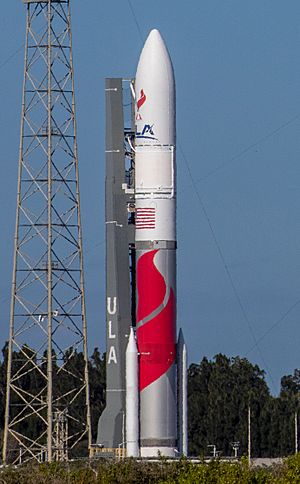Vulcan Centaur facts for kids
 |
|

Vulcan Centaur ahead of its first flight
|
|
| Function | Launch vehicle, partial reuse planned |
|---|---|
| Manufacturer | United Launch Alliance |
| Country of origin | United States |
| Cost per launch | Approx. US$100–200 million |
| Size | |
| Height | 61.6 m (202 ft) |
| Diameter | 5.4 m (18 ft) |
| Mass | 546,700 kg (1,205,300 lb) |
| Stages | 2 with 0, 2, 4 or 6 boosters |
| Capacity | |
| Payload to low Earth orbit (28.7°) | 27,200 kg (60,000 lb) |
| Payload to geostationary transfer orbit (27.0°) | 15,300 kg (33,700 lb), |
| Payload to geostationary orbit | 7,000 kg (15,000 lb) |
| Payload to trans-lunar injection | 12,100 kg (26,700 lb) |
| Launch history | |
| Status | Operational |
| Launch sites |
|
| Total launches | 1 |
| Successes | 1 |
| First flight | 8 January 2024 2:18 AM ET (7:18 UTC) |
| Boosters | |
| No. boosters | 0, 2, 4, or 6 |
| Motor | GEM-63XL |
| Thrust | 2,201.7 kN (495,000 lbf) |
| Fuel | HTPB, Al / AP |
| First stage | |
| Diameter | 5.4 m (18 ft) |
| Engines | 2 × BE-4 |
| Thrust | 1,100,000 lbf (4,900 kN) |
| Fuel | CH4 / LOX |
| Second stage – Centaur V | |
| Diameter | 5.4 m (18 ft) |
| Engines | 2 × RL-10 |
| Thrust | 212 kN (48,000 lbf) |
| Specific impulse | 453.8 s (4.450 km/s) |
| Fuel | LH2 / LOX |
The Vulcan Centaur is a very powerful rocket built by United Launch Alliance (ULA). It has two main parts, or stages, that help it reach space. This rocket is designed to carry very heavy objects into orbit.
The Vulcan Centaur is taking the place of older rockets like the Atlas V and Delta IV Heavy. These older rockets are being retired. The Vulcan Centaur will also be used to launch satellites and spacecraft for different companies.
Work on the Vulcan rocket started in 2014. This was partly because of new competition from companies like SpaceX. It was also to stop using a Russian-made engine, the RD-180, which was used on the Atlas V rocket.
The Vulcan Centaur had its first flight on January 8, 2024. It successfully carried a lunar lander called Peregrine for Astrobotic Technology. This was an important mission for NASA's program to send payloads to the Moon.
How the Vulcan Centaur Was Developed
Over the years, ULA thought about many different rocket ideas. In 2014, ULA started looking for a new engine. They wanted to replace the Russian-made RD-180 engine used in their Atlas V rocket.
In September 2014, ULA announced a partnership with Blue Origin. They would work together to create a new engine called the BE-4. This engine uses liquid oxygen (LOX) and liquid methane (CH4) as fuel. It was designed to power the first part of the new Vulcan rocket.
The first version of the Vulcan was planned to use two BE-4 engines. Its second part was going to be the existing Centaur III, which was already used on the Atlas V. ULA also had an idea to reuse parts of the Vulcan rocket. The engines and some other parts could detach after launch. They would then return to Earth using a special heat shield.
What Can Vulcan Centaur Carry?
The Vulcan Centaur is a very strong rocket. A single Vulcan Centaur with six extra boosters can lift 27,200 kilograms (about 60,000 pounds) into low-Earth orbit. This is almost as much as the Delta IV Heavy, which uses three main rocket cores.
Here is a table showing how much weight the Vulcan Centaur can carry to different places in space:
| Version | SRBs | Payload mass to... | ||||||
|---|---|---|---|---|---|---|---|---|
| LEO | ISS | Polar | MEO | GEO | GTO | TLI | ||
| Vulcan Centaur VC0 | 0 | 10,800 kg (23,800 lb) | 9,200 kg (20,300 lb) | 8,500 kg (18,700 lb) | N/A | N/A | 3,500 kg (7,700 lb) | 2,300 kg (5,100 lb) |
| Vulcan Centaur VC2 | 2 | 19,000 kg (42,000 lb) | 16,300 kg (35,900 lb) | 15,200 kg (33,500 lb) | 3,900 kg (8,600 lb) | 2,600 kg (5,700 lb) | 8,400 kg (18,500 lb) | 6,300 kg (13,900 lb) |
| Vulcan Centaur VC4 | 4 | 24,600 kg (54,200 lb) | 21,600 kg (47,600 lb) | 20,000 kg (44,000 lb) | 6,200 kg (13,700 lb) | 4,900 kg (10,800 lb) | 11,700 kg (25,800 lb) | 9,200 kg (20,300 lb) |
| Vulcan Centaur VC6 | 6 | 27,200 kg (60,000 lb) | 25,800 kg (56,900 lb) | 23,900 kg (52,700 lb) | 8,100 kg (17,900 lb) | 6,500 kg (14,300 lb) | 14,500 kg (32,000 lb) | 11,500 kg (25,400 lb) |
| Vulcan Upgrade | 6 | 27,200 kg (60,000 lb) | 26,900 kg (59,300 lb) | 24,900 kg (54,900 lb) | 8,600 kg (19,000 lb) | 7,000 kg (15,000 lb) | 15,300 kg (33,700 lb) | 12,100 kg (26,700 lb) |
See also
 In Spanish: Vulcan (cohete) para niños
In Spanish: Vulcan (cohete) para niños
- Heavy-lift launch vehicle
- Comparison of orbital launch systems
- OmegA
- New Glenn
- Falcon 9
- Falcon Heavy

